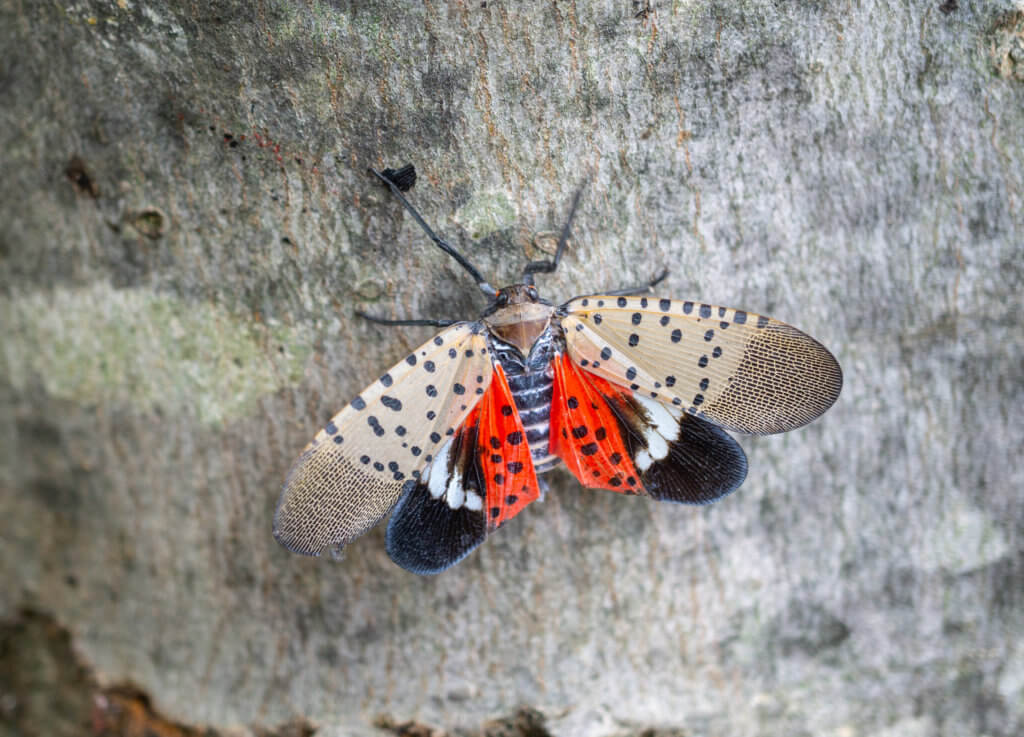Indigenous to eastern Asia, Vietnam, India, and China, these planthoppers made their appearance in southeastern Pennsylvania in 2014. It is thought spotted lanternflies were here more likely two years previous, but at this point it doesn’t even matter. What matters is that they have expanded their reach to at least 12 other states on the Eastern Seaboard and recently have been spotted in none other than New England.

Each state’s Department of Agriculture is asking sightings be reported and citizens to do their part by crushing spotted lanternflies. This is an invasive species that can do some damage. In addition, spotted lanternflies are called planthoppers for a reason. You will see them flying around but not for long. They are not strong flyers and soon will take a break by landing on whatever is closest to them – including you. But they are strong hoppers! Spotted lanternflies will hop fast and far so to crush one, you have to be pretty fast yourself. Reporting spotted lanternflies will help the department of agriculture in your state know where they are most prominent and where to focus their efforts to rid the area of them.
But why are we all up in arms about getting rid of the spotted lanternflies? Here are just a few reasons.
Nuisance pests!
While they do not sting or bite animals or people, spotted lanternflies are a nuisance. Besides being large and a little intimidating (clocking in at about an inch long when they are in flight), spotted lanternflies are not good flyers. Outdoor dining, sporting events, and even just being at the playground can be disrupted. If you’re into bugs, spotted lanternflies are quite pretty with the gray forewings with black spots and red hindwings that give them quite a pop of color! Still don’t want them flying into your head.
Threatening pests!
While spotted lanternflies aren’t a threat to people really, they are able to hop from plant to plant bringing disease with them as they go. The tree of heaven is their preference, but they will make do with anything from black locust and maple trees to many different kinds of fruit trees. Spotted lanternflies hang out together, attacking trees as a swarm. Not only can they spread diseases to the trees, but they weaken them, which makes them more vulnerable to other kinds of diseases.
Threat to fruit!
Spotted lanternflies love fruit. Apples, blueberries, and stone fruits like peaches are some of their favorites as well as many different kinds of vines. No more blueberry pie? An apple pie-free Thanksgiving? A peachless summer? No thanks. Not only do we love all these things, but fresh fruit is part of a healthy diet and provides many different kinds of essential vitamins and nutrients. These plant-hopping pests will not only threaten the trees in our area, but they will also deposit spotted lanternfly eggs in the form of egg masses on the base of the trees, which will hatch and feed on its sap. Either way, it’s not good for those fruit trees and vines. So, report spotted lanternflies and crush them when you see them!

Threat to grapes!
Let’s get serious here. The most important vine spotted lanternflies can threaten are grapevines. Imagine your favorite pasta dish without a full-bodied pinot noir. Or making scampi without a crisp white wine! Not to mention the other whining when we have a shortage of grape jelly. You’ll need that wine more than ever. It’s not just us at home, though. Vineyards from Connecticut to New Hampshire take painstaking efforts to keep their grapevines healthy and free from disease. Winemakers rely on those vines to stay in business, and it’s an important industry in the area. Plus – wine.
We can’t let the spotted lanternfly take over our area like they have in many other areas on the East Coast. Together, by reporting and crushing them, we can help each other and our orchards and vineyards.